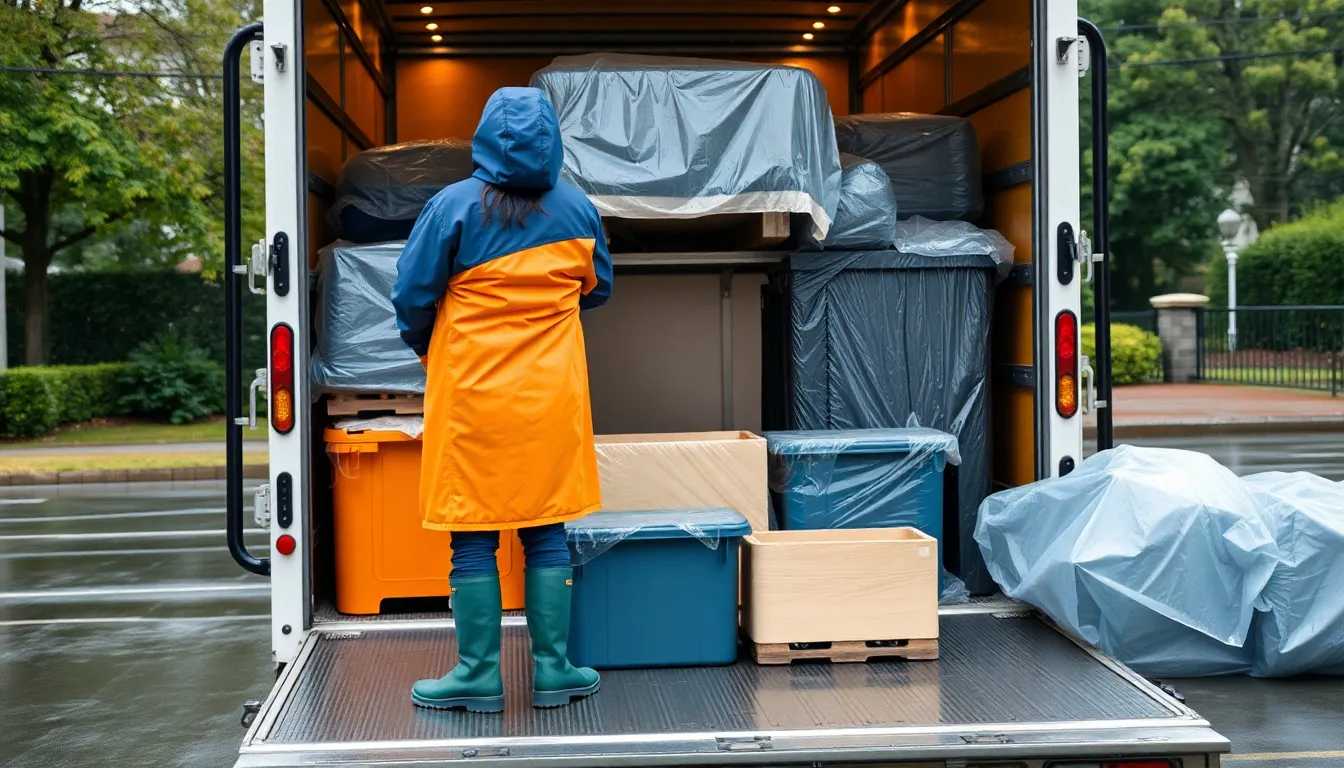Moving day is often a mix of excitement and chaos, but throw in some rain and it becomes a whole new adventure. Picture this: boxes stacked high, furniture ready to be loaded, and suddenly the sky opens up like it’s auditioning for a disaster movie. Instead of panicking, embrace the soggy situation. After all, who doesn’t love a little drama with their packing tape?
Table of Contents
ToggleUnderstanding the Impact of Rain on Moving Day
Rain can significantly affect a moving day experience. It introduces challenges that impact both planning and execution.
Psychological Effects of Rain
Rain often dampens spirits on moving day. Stress levels may rise due to the unpredictability of the weather, making an already complex task feel more daunting. Frustration can increase when navigating wet conditions, especially while handling valuable items. Some individuals might even feel nostalgic, as rain can trigger memories. Foster a positive mindset to combat these feelings. Finding humor in the situation can lighten the mood and keep motivation high.
Practical Challenges Posed by Rain
Rain creates tangible obstacles that complicate moving logistics. Wet floors can lead to slips, increasing the risk of accidents during the move. Packing materials, such as cardboard boxes, aren’t water-resistant, raising the chance of damage to belongings. Keeping items dry necessitates additional planning and protective coverings. Routes might also become challenging if the terrain is muddy or slippery. Prepare to adjust plans as needed, allocating extra time for manageable transport.
Preparing for Rain on Moving Day

Rain complicates the moving process, so preparation is essential. Ensuring items stay dry plays a crucial role in maintaining their condition.
Packing Strategies to Keep Items Dry
Utilizing waterproof containers proves effective for protecting belongings. Choose sturdy plastic bins instead of cardboard boxes for sensitive items. Wrap vulnerable furniture in specialized moving blankets designed for wet conditions. Always use heavy-duty trash bags to pack clothing and linens. Double-bagging can add an extra layer of protection. Identify any items that are particularly susceptible to moisture and prioritize their packing. Cover furniture in plastic sheets or tarps while loading and unloading to minimize exposure. By focusing on these strategies, movers can safeguard their items from water damage.
Essential Supplies for a Rainy Move
Investing in essential supplies makes rainy moves more manageable. Acquire waterproof tarps to cover items during transport. Sturdy moving blankets serve as both protection and insulation from dampness. Ensure that you have ample duct tape and plastic wrap for securing packages tightly. Consider packing materials such as bubble wrap and foam sheets to shield fragile items. Keep extra absorbent towels nearby to wipe off wet surfaces or belongings. Rain gear like raincoats and boots helps keep movers dry and comfortable. These supplies contribute significantly to a successful, smooth moving experience despite the weather.
Strategies for a Successful Move Despite Rain
Navigating a move during rain requires strategy and foresight. With the right planning, individuals can minimize disruptions and ensure everything proceeds smoothly.
Timing Your Move and Weather Considerations
Consider the weather forecast before scheduling a move. Rain patterns may dictate the best time to start the process. Checking for breaks in the rain can help with loading and unloading. Early mornings or late afternoons often present drier conditions. Adjusting the moving timeline based on predicted weather can enhance efficiency. Keeping a close eye on meteorological updates allows for quick decisions regarding logistics.
Hiring Professional Movers with Experience in Rain
Select movers that prioritize experience in adverse weather conditions. Professionals knowledgeable in rainy environments understand how to adapt techniques during wet conditions. With proper training, they use equipment designed to prevent damage from moisture. Ensure movers arrive with waterproof coverings for furniture and boxes. Experience often translates to increased efficiency, reducing the risk of slips and falls. Hiring a skilled team often brings peace of mind in navigating challenges presented by rain.
After the Move: Dealing with Wet Conditions
Rainy conditions after moving day can lead to challenges, but effective strategies exist to manage the situation.
Drying and Cleaning Your Belongings
Start by assessing each item for moisture upon arrival. Use absorbent towels to blot wet surfaces and reduce water exposure. While some items may require air drying, others, like electronics, benefit from immediate attention. Placing items in a well-ventilated area speeds up the drying process. Utilize fans or dehumidifiers to help circulate air and decrease humidity levels inside the new home. Protect floors and carpets by laying down towels where wet items rest. This approach minimizes further damage and helps maintain a clean environment.
Preventing Damage from Water Exposure
To safeguard belongings, ensure proper handling and drying techniques are in place. Store items off the floor in elevated positions to avoid water exposure during wet conditions. For sensitive materials, like important documents, use waterproof containers or plastic sleeves. Applying furniture polish on wooden surfaces creates a protective layer against moisture. Consider immediately inspecting boxes for water damage, especially those containing clothing or paper products. Moisture often leads to mold and mildew growth, so vigilance prevents future issues. Keeping essentials in fully sealed bags ensures added protection against unexpected water exposure.
Rainy weather on moving day can feel daunting but it doesn’t have to ruin the experience. Embracing the challenges that come with wet conditions can lead to unexpected moments of joy and camaraderie. With careful planning and the right supplies, movers can keep their belongings safe and dry while navigating the logistical hurdles posed by rain.
By focusing on preparation and maintaining a positive mindset, the day can still unfold smoothly. Whether it’s utilizing waterproof containers or timing the move strategically, these steps can make all the difference. Ultimately, a rainy move might just become a memorable adventure rather than a stressful ordeal.



